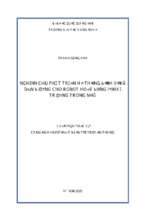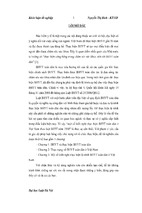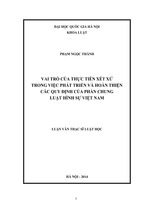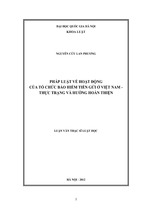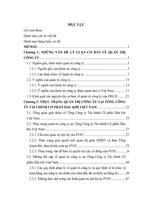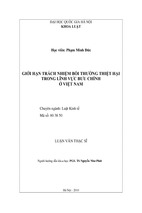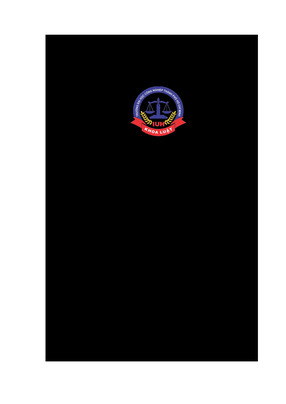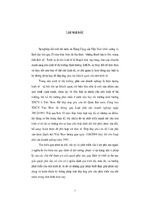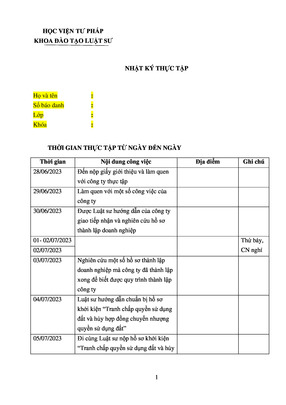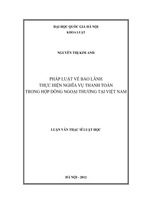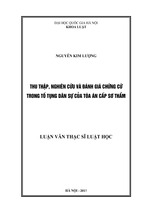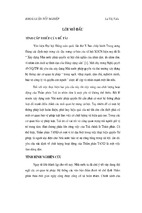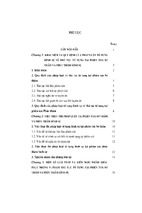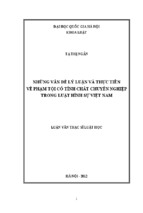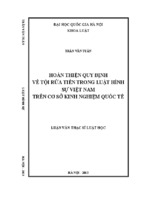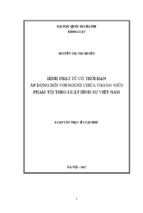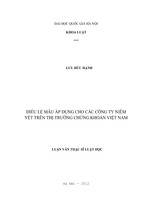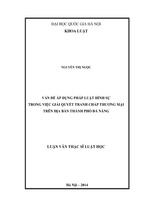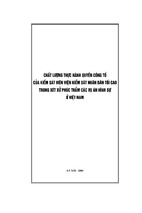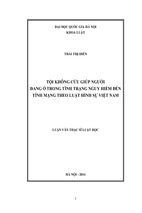HO CHI MINH CITY UNIVERSITY OF LAW
FACULTY OF INTERNATIONAL LAW
-----------***------------
LE THANH THAO
Student ID: 1751101030139
ENHANCE FAIR ACCESS TO COVID-19
VACCINES THROUGH THE WAIVER OF
INTELLECTUAL PROPERTY RIGHTS –
RECOMMENDATIONS FOR VIETNAM
BACHELOR’S THESIS
School Year: 2017 - 2022
Supervisor:
LL.M. Ngo Kim Hoang Nguyen
Ho Chi Minh City – Year 2022
HO CHI MINH CITY UNIVERSITY OF LAW
FACULTY OF INTERNATIONAL LAW
-----------***------------
LE THANH THAO
Student ID: 1751101030139
ENHANCE FAIR ACCESS TO COVID-19
VACCINES THROUGH THE WAIVER OF
INTELLECTUAL PROPERTY RIGHTS –
RECOMMENDATIONS FOR VIETNAM
BACHELOR’S THESIS
School Year: 2017 - 2022
Supervisor:
LL.M. Ngo Kim Hoang Nguyen
Ho Chi Minh City – Year 2022
DECLARATION
I, hereinafter, declare that the bachelor thesis of “Enhance fair access to COVID-19
vaccines through the waiver of Intellectual Property rights - Recommendations for
Vietnam”, which has been carried out under the supervision of LL.M. Ngo Kim Hoang
Nguyen, represents my own research work unless otherwise cited or acknowledged by
means of complete references. Therefore, I take full responsibility for this declaration.
Ho Chi Minh City, June 29, 2022
Le Thanh Thao
TABLE OF CONTENTS
INTRODUCTION ......................................................................................................... 01
CHAPTER I: ACCESS TO COVID-19 VACCINES AS THE FOUNDATION OF
HUMAN RIGHT ........................................................................................................... 09
1.1. Overview of Human rights .................................................................................... 09
1.1.1. Concept of Human rights ............................................................................... 09
1.1.2. Approached tendencies of Human rights ....................................................... 11
1.1.3. Characteristics and features of Human rights ................................................ 12
1.2. Access to COVID-19 vaccines as a human right ................................................ 13
1.2.1. Right to health ................................................................................................ 13
1.2.2. Right to enjoy the benefits of scientific progress and its applications .......... 22
1.2.3. Conclusion ...................................................................................................... 24
1.3. International practice regarding access to COVID-19 vaccines ..................... 26
1.3.1. Introduction to COVID-19 Vaccines Global Access .................................... 26
1.3.2. International vaccination and distribution of COVID-19 vaccines .............. 28
SUBCONCLUSION OF CHAPTER I........................................................................ 31
CHAPTER II: WAIVER OF INTELLECTUAL PROPERTY RIGHTS ON
COVID-19 VACCINES – RECOMMENDATIONS FOR VIETNAM .................. 33
2.1. The interface between Intellectual Property rights and Human rights .......... 36
2.1.1. Approaches to the interface between Intellectual Property rights and Human
rights ........................................................................................................................ 36
2.1.2. Intellectual Property rights, right to health and right to enjoy the benefits of
scientific progress and its applications..................................................................... 37
2.2. Waiver of Intellectual Property rights on COVID-19 vaccines........................ 39
2.2.1 Legal framework for waiving Intellectual Property rights for COVID-19
vaccines ..................................................................................................................... 40
2.2.2. The insufficiency of compulsory licensing and voluntary licensing ............ 49
2.2.3. Global reaction regarding the waiver of Intellectual Property rights on
COVID-19 vaccines ................................................................................................. 56
2.3. Recommendations for Vietnam ............................................................................ 62
2.3.1. Utilizing the Decision on TRIPS Agreement to issue compulsory licenses 62
2.3.2. Other recommendations ................................................................................. 64
SUBCONCLUSION OF CHAPTER II ...................................................................... 68
CONCLUSION OF THESIS ....................................................................................... 70
BIBLIOGRAPHY ......................................................................................................... 72
LIST OF ABBREVIATIONS
ACT-A
CEPI
CESCR
Access to COVID-19 Tools Accelerator
Coalition for Epidemic Preparedness Innovations
Committee on Economic, Social and Cultural
Rights
COVAX
COVID-19
Council for TRIPS
COVID-19 Vaccines Global Access
Coronavirus disease
Council for Trade-Related Aspects of Intellectual
Property Rights
DOHA Declaration
Declaration on the TRIPS agreement and public
health
C-TAP
GAVI
HRs
ICESCR
COVID-19 Technology Access Pool
Global Alliance for Vaccines and Immunization
Human rights
International Covenant on Economic, Social and
Cultural Rights
IP
Intellectual Property
LDCs
Least-developed countries
LOIP
Law on Intellectual Property
Marrakesh Agreement
Marrakesh Agreement Establishing the World
Trade Organization
NGOs
OHCHR
Non-governmental organizations
Office of the United Nations High Commissioner
for Human Rights
TRIPS Agreement
Agreement on Trade-Related Aspects of Intellectual
Property Rights
WHO
World Health Organization
WTO
UDHR
World Trade Organization
Universal Declaration of Human Rights
1
INTRODUCTION
1.
Imperativeness of the study
With deep concern both of the alarming levels of spread and severity and of the
alarming levels of inaction, on March 11, 2020, the World Health Organization has
declared the coronavirus disease (“COVID-19”) caused by the SARS-CoV-2 virus
outbreak a global pandemic. 1
Since then the world has been in a race to develop vaccines that can control the
COVID-19 pandemic. In 2021, more than 250 projects have been initiated for this
purpose, but only 14 of them have been authorized for use, despite being in phase 3
clinical trials. More than 40 other vaccines are also in phase 1/2 clinical trials and show
promising outcomes. 2 However, as WHO especially emphazies “it’s not vaccines that
will stop the pandemic, it’s vaccination”3.
On the other hand, the current situation of COVID-19 vaccination in the world
has shown that COVID-19 vaccines have not been distributed and accessed equitably
leading to the failure of States to comply with their obligation to ensure access to
COVID-19 vaccines for everyone, everywhere since such access is realized to be a
Human right.
One of the main reasons leading to the above problem is the protection of
Intellectual Property (“IP”) rights for COVID-19 vaccines. Even though, IP protection
has a strong and positive impact on socio-economic development, it also has certain
negative effects, especially in the current context of COVID-19 pandemic. IP rights
1
WHO, “WHO Director-General’s opening remarks at the media briefing on COVID-19 - 11 March 2020”,
March 11, 2020, https://www.who.int/director-general/speeches/detail/who-director-general-s-opening-remarksat-the-media-briefing-on-covid-19---11-march-2020 (Accessed on June 10, 2022)
2
Zainalabideen A. Abdulla et al., “A Summary of the SARS-CoV-2 Vaccines and Technologies Available or
under Development”, Pathogens, No. 10(7):788, 2021, page 1
3
WHO, “COVID-19 vaccines”, https://www.who.int/emergencies/diseases/novel-coronavirus-2019/covid-19-
vaccines (Accessed on June 10, 2022)
2
protection is characterized by general IP law, which is territorial. However, the Covid19 pandemic did not stop within the territory of any one country, but created a global
crisis.4 It has become a big deal for countries when they have to fulfill strict obligations
imposed by the TRIPS agreement. Therefore, the first pioneers such as India and South
Africa and then fellow countries have proposed a waiver of IP rights toward COVID19 health products and technologies, including vaccines. Such waiver presents an
important opportunity for all States to unite and protect public health, global solidarity,
and fair access through a concrete step at the international level that can provide an
automatic and expedited solution to collectively address IP and technology challenges. 5
In this context, the TRIPS waiver is a critical legal instrument for enabling a significant
increase in COVID-19 vaccine manufacturing capacity and thus supply, paving the
way for global equitable production and access. 6 In terms of the balance between
economic and social benefits, there is no absolute balance between economic benefits
or social benefits, and to resolve the conflict between Human rights (“HRs”) and IP
rights, it requires a long time of research with the adjustment of a synchronous and
appropriate IP legal system. It should be emphasized that waiver of IP rights for Covid19 vaccines is necessary because IP holders have many opportunities to reap economic
4
Nguyen Van Quan, Vu Thanh Cu, “The right to access vaccines to prevent Covid-19 in the current context”,
Journal of Legislative Studies, Vol. 02+03 (450+451), 2022, http://lapphap.vn/Pages/TinTuc/211029/Quyen-tiepcan-vac-xin-phong-ngua-Covid-19-trong-boi-canh-hien-nay.html, (Accessed on June 13, 2022)
5
Médecins Sans Frontières, India and South Africa proposal for WTO waiver from intellectual property
protections for COVID-19-related medical technologies, Briefing Document, 2020, page 4
6
Siva Thambisetty et al., The TRIPS Intellectual Property Waiver Proposal: Creating the Right Incentitives in
Patent Law and Politics to end the COVID-19 Pandemic, Society and Economy Working Papers, LSE Legal
Studies Working Paper No.06/2021, 2021, page 1
3
profits while less than one year, the COVID-19 pandemic have claimed the lives of
millions of people due to the barriers from the IP system itself. 7
Furthermore, with the vaccination policy for children 5-12 years old8 and the
plan for vaccinating the 2 nd booster shot (4th and other future dose) for those who need
to be vaccinated, including the elderly (60 years old and older), people with
background diseases, workers in industrial zones or crowded areas 9, Vietnam, at the
present, still has a high demand for COVID-19 vaccines. In other words, Vietnam still
need to enhance the access of our children to COVID-19 vaccination and our
poupulation in general to the 4th and other future dose vaccination and the waiver of IP
rights shall act as a necessary legal instrument that will assist Vietnam in this regard.
With the desire to study in detail, specifically and thoroughly about the access
vaccines from the perspective of HRs and the waiver of IP rights toward CVOID-19
vaccines, the author decided to choose the topic “Enhance fair access to COVID-19
vaccines through the waiver of Intellectual Property rights – Recommendations for
Vietnam” as the topic of Bachelor of Law thesis.
2.
Literature review
Generally, access to medicines is not a new topic. However, when placed in the
context of the COVID-19 pandemic affecting the health of all mankind and causing the
death of millions of people, the issue of access to medicines, specifically in this thesis,
is the access to COVID-19 vaccines is of greater concern than ever. While global
7
Nguyen Van Phuc, “Waiver of Intellectual Property rights for COVID-19 vaccines to access the community's
entitlement
to
health
care”,
Journal
of
Legislative
Studies,
Vol.
08
(456),
2022
http://www.lapphap.vn/Pages/tintuc/tinchitiet.aspx?tintucid=211080 (Accessed on June 29, 2022)
8
Resolution No. 55/NQ-CP dated April 14, 2022 of the Government Office of Socialist Republic of Vietnam on
COVID-19 vaccination for children from 5 to 12 years old
9
Notification No. 114/TB-VPCP dated April 15, 2022 of the Government Office of Socialist Republic of
Vietnam on the Conclusion of Prime Minister Pham Minh Chinh at the 14th online meeting of the National
Steering Committee for COVID-19 prevention and control with localities, paragraph 5, page 3
4
practice shows that COVID-19 vaccination is taking place inequitably and the world is
struggling and having difficulty in enhancing fair10 access to COVID-19 vaccines, the
appearance of the proposal of the waiver as a legal instrument that allows countries to
temporarily refrain from WTO’s obligations related to the protection of IP rights in the
TRIPS Agreement raise another interesting concern. Approaching this topic with the
above issues, the author has referenced the following works:
2.1.
Domestic Studies:
Nguyen Ho Bich Hang, “COVID-19 and Challenges to Intellectual Property
Rights”, Vietnamese Journal of Legal Science, Vol. 04 (143), 2021, page 27-41.
Nguyen Van Phuc, “Waiver of Intellectual Property rights for COVID-19 vaccines
to access the community's entitlement to health care”, Journal of Legislative
Studies, Vol. 08 (456), 2022.
Nguyen Van Quan, Vu Thanh Cu, “The right to access vaccines to prevent Covid19 in the current context”, Journal of Legislative Studies, Vol. 02+03 (450+451),
2022.
2.2.
International Studies:
De Menezes, Henrique Zeferino, The TRIPS waiver proposal: An urgent measure
to expand access to the COVID-19 vaccines, Research Paper No. 129, South
Centre, Geneva, 2021.
International AIDS Society and Desmond M Tutu Endowment in Public Health and
Human Rights at the Johns Hopkins University, “Human rights and fair access to
COVID-19 vaccines: the International AIDS Society–Lancet Commission on
Health and Human Rights”, The Lancet, Vol. 397, 2021.
Philip Loft, Waiving intellectual property rights for Covid-19 vaccines, Research
Briefing No. 9417, House of Commons Library, 2022.
10
Within this thesis, the word “fair” and “equitable” shall be used in the same manner without any important
differences, indicating that they are interchangeable.
5
Prabhash Ranjan, The Case for Waiving Intellectual Property Protection for
COVID-19 Vaccines, Issue Brief, Issue No. 456, Observer Research Foundation,
2021.
Along with a number of other domestic and international research works related
to either the issue of access to COVID-19 vaccines as a Human right or the waiver of
IP rights or both.
Considering from beginning of the COVID-19 pandemic to the present, the
author finds that, there are very few domestic studies connecting both the issues of
access to COVID-19 vaccines as a Human right and the waiver of IP rights and there is
no research work, to the extent of the author’s research, on accessing to COVID -19
vaccines for children and 2 nd booster shot for those who are appropriate. In addition,
the author finds that the most recent international research works are likely to focus
more on the issue of waiving IP rights. Therefore, through reference from domestic and
international studies, the author wishes to inherit previous studies to develop deep
research on both issues at the same time. With explanations, commentaries of
international regulations from international authorities, relevant research works, and
simultaneously assessing the actual situation, the author would observe on the issues
surrounding the enhancement of fair access to COVID-19 vaccines through the waiver
of IP rights in the current context.
3.
Purposes of the study
Studying the bachelor thesis named “Enhance fair access to COVID-19 vaccines
through the waiver of Intellectual Property rights - Recommendations for Vietnam”,
the author seeks to achieve these following purposes:
First, the author studies in general the theoretical basis and in detail the legal
framework of access to COVID-19 vaccines concerning Human right and waiving IP
rights on COVID-19 vaccines.
6
Second, the author presents the current situation and points out the causes
leading such situation of the above issues.
Third, the author offers several recommendations for Vietnam to take into
account for future actions.
4.
Objectives and Scope of the study
4.1.
Objectives of the study
The objectives of the study are theoretical basis, legal framework and actual
situation related to access to COVID-19 vaccines concerning Human right and waiving
IP rights on COVID-19 vaccines in the world. Thereupon, the thesis shall provide some
recommendations for Vietnam to consider for next steps.
4.2.
Scope of the study
The author studies the access to COVID-19 vaccines concerning Human right
and waiver of IP rights on COVID-19 vaccines based on theoretical basis and legal
framework including certain significant international regulations, legal documents
together with their explanations and commentaries. Particularly, regarding the access to
COVID-19 vaccines concerning Human right, the thesis will concentrate on studying
this issue under two aspects which are the right to health and the right to enjoy the
benefits of scientific progress and its applications. In regard to the waiver of IP rights
on COVID-19 vaccines, the author shall focus on analyzing the legal basis for the
establishment as well as legal framework of such waiver, the insufficiency of
compulsory licensing and voluntary licensing as the two alternatives to the waiver. In
addition, the author will also address the actual situation surrounding both issues,
thereby making some recommendations for Vietnam.
In terms of limitations, the author shall not cover all international regulations
but only concentrates on prominent and notable ones as presented in this thesis. The
thesis also does not focus on analyzing the laws of any country related to the topic, nor
does it discuss issues such as parallel imports and exhaustion of rights, research
7
exception and provision, measures such as implementing restriction or ban on the
export of COVID-19 vaccines.
5.
Research methodologies
The following research methodologies were employed by the author to conduct
this thesis:
First of all, in Chapters I and II, historical review method is combined with the
description method to explain concepts, definitions, perspectives, approaches,
tendencies, and legal provisions. For instance, the concept of HRs, the definition of
health, articles concerning the right to health, the right to enjoy scientific progress and
its application, and so on.
Second, the analysis methodology is adopted throughout the thesis to provide an
analytical perspective on international bodies’ statements, comments, and responses
concerning access to COVID-19 vaccines and waiver of COVID-19 vaccines’ IP
rights. The author then proceeds to discuss the characteristics, benefits, drawbacks, and
conclusions associated with such issues.
Third, in order to identify the difference between the documents such as the
original waiver proposal of India – South Africa, the later revised and summarized
waiver proposal of the Co-sponsors, the compromise waiver proposal of the Quad, or
the Decision on TRIPS Agreement, the author did use comparative method.
Finally, the author uses the synthesis method throughout all chapters to select
and arrange gathered information so that it can be used in a rational manner.
All of the aforementioned methodologies are utilized in conjunction with one
another to maximize the effectiveness of this thesis.
6.
Thesis structure
This thesis comprises two chapters as follows:
Chapter I: Access to COVID-19 vaccines as the foundation of Human right
8
Chapter II: Waiver of Intellectual Property Rights on COVID-19 vaccines –
Recommendations for Vietnam
9
CHAPTER I: ACCESS TO COVID-19 VACCINES AS THE FOUNDATION OF
HUMAN RIGHT
In this chapter, the thesis shall first provide the concept, approached tendencies
and characteristics of Human rights to give an overview about this right. Then, based
on the right to enjoy the highest attainable standard of physical and mental health and
the right to enjoy the benefits of scientific progress and its applications, the chapter
continues by analyzing that access to COVID-19 vaccines, in essence, is a Human
right. Finally, this chapter shall demonstrate the global practice regarding access to
COVID-19 vaccines by give an introduction about an international joint initiative
called COVAX and indicate the current global status of COVID-19 vaccines
distribution and vaccination.
1.1.
Overview of Human rights
1.1.1. Concept of Human rights
The concept of Human rights first appeared on the international agenda when
the United Nations Charter declared in 1945 that the United Nations was determined 11
“to reaffirm faith in fundamental human rights, in the dignity and worth of the human
person, in the equal rights of men and women, and of nations large and small.”12
After that, the event of the adoption of the Universal Declaration of Human
Rights (“UDHR”) by the United Nations General Assembly on December 10, 194813
made it the first legal document to form the universal protection of fundamental HRs
and is the basis of all international HRs law.14 Pursuant to this declaration, “all human
beings are born free and equal in dignity and rights. They are endowed with reason
11
Michael Freeman, Human Rights, Key Concepts Series, Fourth Edition (Fully Revised and Updated), 2022,
page 10 - 15
12
Charter of the United Nations 1945, Preamble, Section 1
13
Michael Freeman (2022), Supra note 11, page 10 - 15
14
OHCHR, “What are human rights?”, https://www.ohchr.org/en/what-are-human-rights (Accessed on May 8,
2022)
10
and conscience and should act towards one another in a spirit of brotherhood.” 15 And
that “everyone is entitled to all the rights and freedoms set forth in this Declaration,
without distinction of any kind, such as race, colour, sex, language, religion, political
or other opinion, national or social origin, property, birth or other status.
Furthermore, no distinction shall be made on the basis of the political, jurisdictional
or international status of the country or territory to which a person belongs, whether it
be independent, trust, non-self-governing or under any other limitation of
sovereignty.”16
Following this Declaration, in related international documents, the Office of the
United Nations High Commissioner for Human Rights (“OHCHR”) has defined
Human rights as follows “human rights are commonly understood as being those rights
which are inherent to the human being. The concept of human rights acknowledges
that every single human being is entitled to enjoy his or her human rights without
distinction as to race, colour, sex, language, religion, political or other opinion,
national or social origin, property, birth or other status.”17 Moreover, they are
“universal legal guarantees protecting individuals and groups against actions and
omissions that interfere with fundamental freedoms, entitlements and human dignity.
Human rights law obliges Governments (principally) and other duty-bearers to do
certain things and prevents them from doing others.”18
In conclusion, HRs are based on a universal set of ethical values that aims at
ensuring that each individual life is valued equally, and that applies to all people at all
times and in all places. 19
15
Universal Declaration of Human Rights 1948, Article 1
16
Universal Declaration of Human Rights 1948, Article 2
17
OHCHR, United Nations Staff College Project, Human Rights – A Basic Handbook for UN Staff, page 2
18
OHCHR, Frequently Asked Question On A Human Rights-based Approach To Development Cooperation,
2006, page 1
19
Darren J. O’Byrne, Human Rights – An introduction, Routledge, 2013, page 26, 27
11
1.1.2. Approached tendencies of Human rights
In traditional, there are two tendencies to approach HRs. Based on the
combination of those two tendencies, the last tendency appears. They are detailed as
follows:
The first tendency emphasizes the natural attribute of HRs, that is, a human
being will have rights.
20
A natural right is one that a person has simply by virtue of
being human. As it is associated with human nature, it is held universally and equally
by all human beings.21 Accordingly, HRs are innate, inherent that all individuals are
born to have, simply because they are members of the human family. Therefore, HRs
do not depend on customs, traditions, cultural traditions or the will of any individual,
class, class, organization, community or State. Likewise, no entity, including States,
can grant or arbitrarily take away HRs. 22
On the contrary, the second tendency emphasizes the artificial attribute of HRs,
arguing that rights are agreed upon by people or prescribed by the State in the law.
Accordingly, HRs are not innate, inherent but must be regulated by the State in the law.
Thus, according to this theory, the scope, limits and to a certain extent, the validity
period of HRs depends on the will of the ruling class and factors such as customs,
practices and traditions. cultural traditions of each society. 23
The third tendency is a combination of the two approaches mentioned above.
Accordingly, this approach holds that HRs have both a natural attribute, innate and
20
Vu Cong Giao et al., Question and Answer on Human Rights, Rights and Obligations of Citizens (Revised and
Supplemented Edition), National Political Publishing House, Hanoi, 2016, page 10
21
Jack Donnely, “Human Rights as Natural Rights”, Human Rights Quarterly, Vol 4 No.3, 1982, page 397
22
Vu Cong Giao et al. (2016), Supra note 20, page 11
23
Vu Cong Giao et al., (2016), Supra note 20, page 10, 12
12
inherent in each individual, but at the same time are also governed by artificial
attributes such as legal factors and cultural, and political differences. 24
1.1.3. Characteristics and features of Human rights
All HRs are universal, indivisible and interdependent and interrelated25 and
inalienable26. These are the most essential characteristics and features of HRs. In
particular, these characteristics are demonstrated below:
First, human rights are universal as mentioned in the first approach in Section
1.1.1.b. International HRs law is based upon the principle of universality of HRs.27
They are with us irrespective of ethnicity, race, gender, sexuality, age, religion,
political beliefs, or government type. 28
Second, human rights are inalienable. The preamble of the Universal
Declaration of Human Rights states in its first sentence that “Whereas recognition of
the inherent dignity and of the equal and inalienable rights of all members of the
human family is the foundation of freedom, justice and peace in the world”. Except in
specific circumstances or after due process 29, no one’s HRs can be waived or taken
away. 30
Third, human rights are indivisible, interdependent and interrelated. No human
right is inherently inferior to another, according to the principle of their indivisibility.
On an equal footing with civil and political rights, economic, social, and cultural rights
must be respected, protected, and realized. The interdependence principle
24
Ho Chi Minh City University of Law, Monograph Book of Human Rights in International and Vietnamese law,
Hong Duc Publishing House - Vietnam Bar Association, Ho Chi Minh City, 2014, page 20
25
Vienna Declaration and Programme of Action 1993, Part I, paragraph 5
26
Universal Declaration of Human Rights 1948, Preamble, Section 1
27
OHCHR, Supra note 14 (Accessed on May 8, 2022)
28
Darren J. O’Byrne (2013), Supra note 19, page 27
29
OHCHR, Supra note 14 (Accessed on May 8, 2022); See also OHCHR, Supra note 17, page 2
30
OHCHR (2006), Supra note 18, page 1
13
acknowledges the difficulty (and, in many circumstances, impossibility) of achieving
any single human right in isolation.31“This means that one set of rights cannot be
enjoyed fully without the other.”32
1.2.
Access to COVID-19 vaccines as a human right
First of all, vaccine is “a type of medicine that trains the body’s immune system
so that it can fight a disease it has not come into contact with before. Vaccines are
designed to prevent disease, rather than treat a disease.”33 While pursuant to the
National Cancer Institute of National Institutes of Health of US Department of Health
and Human Services’ Dictionary, medication is defined as “the form with the active
ingredient that used to prevent, diagnose, treat, or relieve symptoms of a disease or
abnormal condition.”34 Hence, medication includes vaccines in general and COVID-19
vaccines in particular.
1.2.1. Right to health
According to WHO, health is defined as “a state of complete physical, mental
and social well-being and not merely the absence of disease or infirmity” 35 and “the
enjoyment of the highest attainable standard of health is one of the fundamental rights
of every human being without distinction of race, religion, political belief, economic or
social condition.”36
31
OHCHR (2006), Supra note 18, page 2
32
OHCHR, Supra note 14 (Accessed on May 8, 2022)
33
Oxford Vaccine Group, “What is a vaccine, and how do vaccines work?”, January 03, 2019,
https://vk.ovg.ox.ac.uk/vk/how-do-vaccines-work (Accessed on May 17, 2022)
34
Within this thesis, the word “medication”, “medicine” and “drug” shall be used interchangeably. See National
Cancer Institute, NCI Dictionaries, “Medication”,
https://www.cancer.gov/publications/dictionaries/cancer-terms/def/medication (Accessed on May 17, 2022)
35
Constitution of the World Health Organization 1946, Preambles, Section 1
36
Constitution of the World Health Organization 1946, Preambles, Section 2
- Xem thêm -


